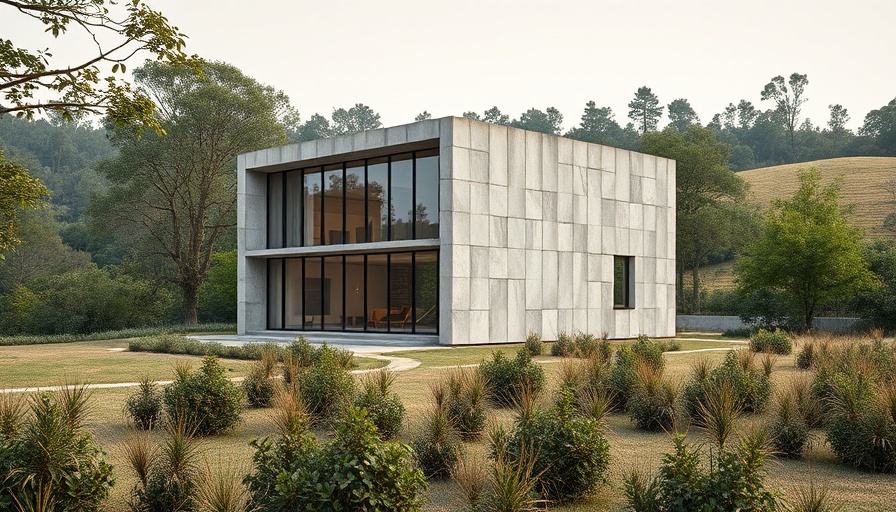
Design That Connects: The Beauty of Nature in Palo Quemado House
Hebra Arquitectos’ latest project, the Palo Quemado house, serves as a stunning example of how architecture can harmoniously blend with the natural environment. Located in the picturesque Los Ríos region of southern Chile, this wood-clad residence is specifically designed to orient itself toward Lake Ranco, offering its residents breathtaking views of the vast body of water.
Constructed for a family looking for a holiday retreat, the home is thoughtfully laid out in a V-shaped form that maximizes both sunlight and scenic vistas. The design features two main volumes rotated at 45 degrees, allowing the house to capture sunlight on its northern façade while also framing the lake view to the south. This intentional orientation underscores the architects' commitment to creating a space that truly resonates with its landscape.
Incorporating Natural Materials: A Touch of Community
One of the defining characteristics of the Palo Quemado house is its use of native woods. Hualle oak is prominently featured on both the exterior and interior, along with coigüe used for furniture elements. This choice of materials is significant not only for its aesthetic appeal but also for its ability to ground the design in the local context. It reflects the architects' vision of connecting the home with its surroundings, promoting a sense of community and comfort.
Similar to the Apfel House, another impressive creation from Hebra Arquitectos, the use of local materials ties these structures to their environments. Apfel House, perched atop a ridge overlooking a valley, employs elements familiar to local barn architecture, creating continuity and familiarity within the Chilean landscape.
Functionality Meets Style: Designing Efficient Workspaces in a Holiday Home
The Palo Quemado house balances public and private areas cleverly. One of the main volumes houses a double-height kitchen, living room, and dining area, providing ample space for family gatherings. The design includes tall glass panels that allow natural light to flood these living spaces, enhancing their functionality.
For digital nomads, this home offers a unique opportunity: the inclusion of a dedicated media room and office space on an upper mezzanine. Gazed walls provide an airy, open feel, making it an ideal environment for remote work while enjoying the relaxing aspects of a holiday home. In an increasingly digital world, having a dedicated workspace within a beautiful natural setting can significantly enhance productivity.
Maximizing Space: Innovative Sleeping Arrangements
The sleeping arrangements at Palo Quemado cleverly accommodate visitors with a mix of flexibility and comfort. Guest rooms are designed with ingenuity—featuring a double bed at the base and additional beds above. This thoughtful design allows for customizable sleeping configurations based on the needs of guests, making it easier to host family visits and ensuring that everyone can have a comfortable space.
Emphasizing Sustainability: A Step Toward Eco-Friendly Architecture
Architecture today faces the pressing challenge of sustainability, and Hebra Arquitectos addresses this head-on in the Palo Quemado house. Utilizing earthy materials, optimizing natural light, and designing for climate responsiveness all contribute to a reduced environmental footprint. This reflects a shift towards more eco-conscious architectural practices, which not only benefit the occupants but also the broader ecosystem.
As shown in both the Palo Quemado and Apfel houses, contemporary Chilean architecture is evolving to integrate sustainability into its fundamental design principles. This evolution is essential for the future of home living, particularly as more individuals work remotely and seek to reside in harmony with nature.
Creating Your Space: Tips for Digital Nomads
For those interested in creating a comfortable remote workspace, consider the following tips:
- Choose Natural Light: As seen with tall glass panels in the Palo Quemado house, incorporating ample natural light can boost your mood and enhance your productivity.
- Utilize Local Materials: Create a sense of belonging by using materials that resonate with your local environment.
- Design for Flexibility: Include multi-purpose areas that can cater to family gatherings or serve as workspaces.
- Focus on Comfort: Ensure your work area is ergonomic, with furniture that supports long hours of productivity.
- Integrate Nature: Bringing elements of nature indoors can have calming effects—think plants, natural textures, and scenic views.
Conclusion: Embrace the Beauty of Work-Life Balance
The Palo Quemado house by Hebra Arquitectos exemplifies beautiful and functional architecture that enhances the quality of life for its inhabitants. The integration of innovative design, natural materials, and a focus on sustainability highlights a growing trend toward creating comfortable remote workspaces within residential homes. If you’re exploring new ways to boost your productivity while working remotely, look to the principles of this remarkable house. Adapting aspects of its design could inspire you to create a workspace that not only looks good but also feels good. Consider making adjustments to your home workspace today—embrace the beauty of your environment and improve your working experience!
 Add Row
Add Row  Add
Add 




Write A Comment